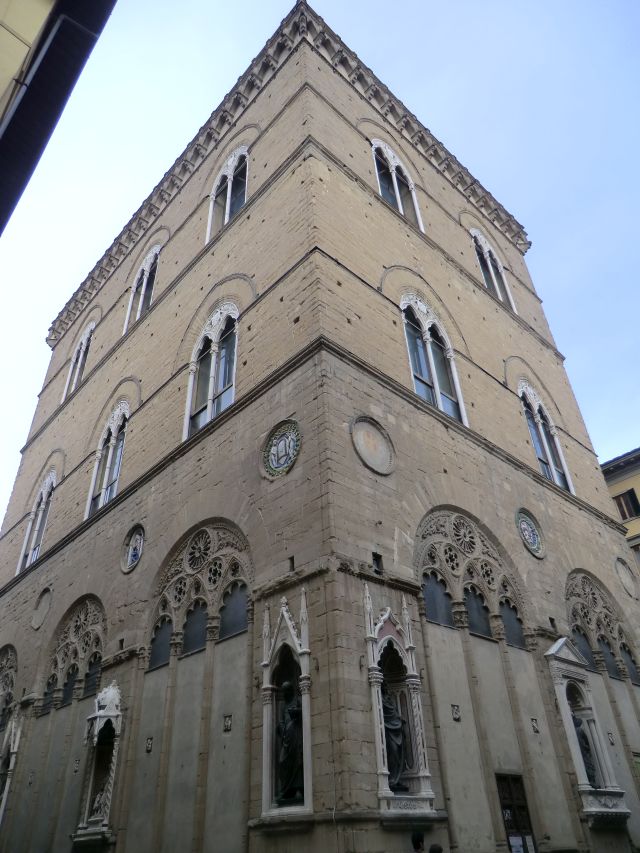
Lior Aviv
Authorized tour guide to Florence and Rome
Lior Aviv
Authorized tour guide to Florence

Places which can be included in the visits
This visit introduces 'instruments' or insights that once understood, will unlock the secret language hidden within works of art. Not only will this opportunity offer deeper understanding of works observed in the Uffizi by such artists as Leonardo da Vinci, Michelangelo, Raphael, Titian, the skills acquired can be used afterwards in reading art in other places around the world near or far from home
Academy Gallery
This visit offers the chance to admire the beauty and perfection of Michelangelo's David and lead on to reflecting on his mighty unfinished statues - statues never completed and defined by the artist himself as the tragedy of his life. Here too, paintings by Botticelli and Perugino and other Renaissance artists can be closely observed with the aim of learning to read and understand rules that will unlock the secret language in the works.
The Bargello Museum
Once a notorious prison, in the 19th Century Il Bargello became one of the most important sculpture museums of the world. A Florentine jewel, the museum houses a priceless collection of sculptures by such masters as Donatello, Verrocchio and Michelangelo. With these sculptures often standing side by side in the lofty expanses of Bargello, we can begin to comprehend the depth of brilliance of these Renaissance sculptors and those who followed.
The Palatine Gallery at the Pitti Palace
The Palatine Gallery is the primary art gallery of the Pitti Palace, one time home of the Medici family in Florence. In sumptuous rooms, hundreds of works once part of private collections can be enjoyed and studied by all. Paintings from the time of the Renaissance through the Baroque by masters such as Raphael, Perugino, del Sarto, Titian and Rubens can be considered. Again, learning together to understand these images with 'instruments' or insights that unlock their secret language will invite greater comprehension of the works.
The New Opera del Duomo Museum
The newly renovated museum of the Opera del Duomo has a great collection of works of art originally located either in the Duomo (Cathedral), the Bell Tower or the Baptistery of Florence. Amongst wonderful statues by Donatello and Michelangelo, there is now a fascinating new reconstruction of the original façade of the Duomo as it appeared until the 16th century. The particular focus of this visit will be religious art and how it changed from one period to another as well as noting how some artists managed to transmit personal messages of their own through their works.
Palazzo Davanzati
In this carefully and appropriately restored building of the 14th Century, visitors have the rare opportunity to experience Florence of the late Middle Ages to early Renaissance from within a home. Furniture, furnishings and items of daily use tell their story, but with other detailed facts and explanations provided during the visit, past lives become clearer. Particularly of interest is the insight that experiencing this home environment gives to the lives and place of women within society during the period.
Palazzo Vecchio
This monumental palace topped with its mighty tower has observed the life of Florence for seven centuries. Known as the Old Palace (Palazzo Vecchio), it received this name only when the Medici Dukes moved to their 'new' palace on the other side of the Arno (Palazzo Pitti) in the middle of the 16th Century. Today Palazzo Vecchio serves as the City Hall of Florence but it has a very colorful, even brutal past. This visit will highlight the manner in which the rulers of Florence used art in the service of power. The frescoes in the palace, the monumental sculptures in the piazza including Michelangelo's great David (the replica) and those in the adjoining Loggia dei Lanzi, all form part of this story of authority and control.
Church of Santa Croce
This Franciscan Church is one of the most famous in Florence not only for its wealth of art but because many greats of Western culture are buried within its walls - Michelangelo and Galilei Galileo are just two examples. Giotto, Donatello and Brunelleschi are names that will be found here in sculpture, painting and architecture but beyond enjoying the art and history, a visit to Santa Croce presents an opportunity find the way art, and particularly religious art, was used to transmit social messages.
Church of Santa Maria Novella
This wonderful Dominican church, from which the train station of Florence takes its name, began its life at the end of the 13th century. Michelangelo named her ‘la mia sposa’ translating as ‘my bride’ perhaps because of his involvement there as a young apprentice in the early years of a very long life. As with Santa Croce, here too there is an opportunity to discover the manner in which religious art was used to transmit social and instructive messages ranging from codes of behavior to education. This magnificent church houses great frescoes, paintings and sculptures by an endless list of artists including Giotto, Masaccio, Brunelleschi, Ghirlandaio and Lippi.
Church of Santo Spirito
This Augustinian church of the Holy Spirit is located on the southern, yet no less beautiful and fascinating, side of the River Arno, the Oltrarno. Rich with works that traverse from Middle Ages through Renaissance to Baroque, it is the perfect location to recognize the various stages and periods of artistic styles. Apart from enjoying the undoubted beauty and space of this great church, the purpose of this visit is to gather skills of observation that can be applied afterwards in other places.
Church of San Lorenzo
Easily recognized in Florence thanks to the fact that after more than five hundred years still it has no finished facade, this church is an elegant beauty of the Renaissance designed by Filippo Brunelleschi. As with every church, gallery and museum of Florence, this great space is studded with works by admired artists, but it also offers the perfect opportunity to experience in situ the principles of Renaissance architecture with its sense of order and the concept fundamental to its artistic style of a 'world under control'.
Church of Santa Trinità
This fascinating and relatively simple church still retains a strong sense of its Gothic roots. Beautifully decorated with works of art that include sculpture, frescoes and paintings, once again it is possible to observe the way in which messages were transmitted to believers through art. Often quiet and dimly lit, this church retains a serenity that speaks of times past.
Orsanmichele
How did a granary become a church with a following of devoted worshippers? What was the meaning of its strange name? In visiting this very particular building of Florence, all will become clear. Standing in the very heart of Florence, Orsanmichele is not always on the list of popular tour itineraries but it is in fact totally unique. As interesting on the outside as it is on the inside, wonderful statues by great sculptors fill niches on all four sides but beautiful as they are, these sculptures are copies. However, thanks to volunteers, the first and second floors of the building are accessible in specific days offering the chance to see many of the original sculptures quite closely as they are displayed on low plinths. An added bonus is the opportunity to enjoy superb views over the city in every direction.
9160 815 329 39 +
9160 815 329 39 +









